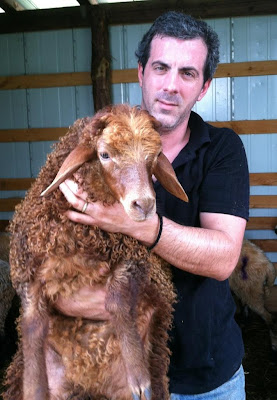Contagious Foot Rot
Contagious Foot Rot is a chronic, discouraging and painful disease that has a severe side effect on sheep.
Foot rot is caused by the combined action of two bacteria, one of which is common in all sheep feces and another that must be introduced by an infected sheep. The combined action of the bacteria affects the horny portion of the hoof, undermining the sole specifically and causing it to separate from the connecting tissue sand hoof wall. Severe lameness and pain occurs; sheep often crawl about on their front knees to take weight off the affected limbs. The putrid odor from the infected hooves attracts blowflies resulting in outbreak of fly maggots on the feet, chest and under wool contaminated by discharge of the feet. This is very contagious. The infectious bacteria spread easily from infected feet to soil in moist environments, and then back to the feet of other sheep where it soon undermines a great portion of the flock. Outbreaks with 15-30% of animals infected are not uncommon. The bacteria does not survive long in dry soil or in manure (approximately two weeks), but they may persist for several weeks when walled off in the hoof of an apparently recovered sheep. This makes the carrier sheep a walking time bomb that can go off during any rainy period continuing the cycle.
Walk affected sheep through foot baths of water and zinc sulfate to help control the bacteria. When bacteria appear inspect every hoof of every sheep and separate those with no foot rot or lesions. Run them through a clean foot bath of 10% zinc sulfate and place them on an area where there have been no sheep with foot rot for several weeks or preferably months. Check the sheep every other day and remover any lame sheep.
Those animals with foot rot should be culled from the flock ASAP if economically possible. If culling is not possible, trim all of their feet and treat them by zinc footbath each week for three weeks. Re-check all feet; remove any sheep that haven’t recovered. Keep infected sheep separate from the clean flock for another six to twelve weeks, checking weekly and removing any that relapse. When this group has remained free of foot rot for six to twelve weeks, you may integrate them with members of the clean flock.
Be sure to not bring in any animals with foot rot to your flock. All new sheep should be isolated from resident sheep for at least 30 days with a foot examination at the beginning and end of that period. Any animal with foot rot or foot rot symptoms should not enter the flock. A vaccine is available and should be considered for use in flocks that cannot eliminate foot rot. The vaccine cannot eliminate foot rot but it can clear it up.
Foot Rot Remedy
Mix this footbath and follow the direction for soaking the foot rot affected hooves.
Ingredients: 50lbs of zinc sulfate with 36% zinc and water.Create a 10% solution which equals 8lbs of zinc sulfate and 10 gallons of water. Pour the solution between two buckets for three to five minutes; then place into a trough structure to be used as a footbath. Place a clear water footbath in front of the zinc footbath to aid in cleaning the feet prior to entering the medicated bath.
Be a good Sheppard and tend to your sheep.
Sincerely,















